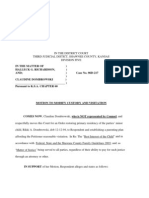0 ratings0% found this document useful (0 votes)
114 viewsElectric Shock: Presented By: Jignasha Patel
Electric Shock: Presented By: Jignasha Patel
Uploaded by
BhargavElectric shock occurs when a person comes into contact with an electrical energy source, causing electrical current to flow through their body. The severity of injuries from electric shock can vary widely, from no harm to death, depending on factors like voltage, current pathway through the body, and duration of contact. Common injuries include burns, broken bones from muscle contractions, and internal damage. Treatment depends on the nature and extent of injuries but may include wound care, surgery, and addressing complications like infection. With prompt medical treatment and no severe burns, most people who experience electric shock survive.
Copyright:
© All Rights Reserved
Available Formats
Download as PPSX, PDF, TXT or read online from Scribd
Electric Shock: Presented By: Jignasha Patel
Electric Shock: Presented By: Jignasha Patel
Uploaded by
Bhargav0 ratings0% found this document useful (0 votes)
114 views22 pagesElectric shock occurs when a person comes into contact with an electrical energy source, causing electrical current to flow through their body. The severity of injuries from electric shock can vary widely, from no harm to death, depending on factors like voltage, current pathway through the body, and duration of contact. Common injuries include burns, broken bones from muscle contractions, and internal damage. Treatment depends on the nature and extent of injuries but may include wound care, surgery, and addressing complications like infection. With prompt medical treatment and no severe burns, most people who experience electric shock survive.
Original Description:
o
Original Title
Electric Shock
Copyright
© © All Rights Reserved
Available Formats
PPSX, PDF, TXT or read online from Scribd
Share this document
Did you find this document useful?
Is this content inappropriate?
Electric shock occurs when a person comes into contact with an electrical energy source, causing electrical current to flow through their body. The severity of injuries from electric shock can vary widely, from no harm to death, depending on factors like voltage, current pathway through the body, and duration of contact. Common injuries include burns, broken bones from muscle contractions, and internal damage. Treatment depends on the nature and extent of injuries but may include wound care, surgery, and addressing complications like infection. With prompt medical treatment and no severe burns, most people who experience electric shock survive.
Copyright:
© All Rights Reserved
Available Formats
Download as PPSX, PDF, TXT or read online from Scribd
Download as ppsx, pdf, or txt
0 ratings0% found this document useful (0 votes)
114 views22 pagesElectric Shock: Presented By: Jignasha Patel
Electric Shock: Presented By: Jignasha Patel
Uploaded by
BhargavElectric shock occurs when a person comes into contact with an electrical energy source, causing electrical current to flow through their body. The severity of injuries from electric shock can vary widely, from no harm to death, depending on factors like voltage, current pathway through the body, and duration of contact. Common injuries include burns, broken bones from muscle contractions, and internal damage. Treatment depends on the nature and extent of injuries but may include wound care, surgery, and addressing complications like infection. With prompt medical treatment and no severe burns, most people who experience electric shock survive.
Copyright:
© All Rights Reserved
Available Formats
Download as PPSX, PDF, TXT or read online from Scribd
Download as ppsx, pdf, or txt
You are on page 1of 22
ELECTRIC SHOCK
PRESENTED BY : JIGNASHA PATEL
“Electric shock is the physiological
reaction, sensation, or injury caused
by electric current passing through the
(human) body. It occurs upon contact of a
(human) body part with any source
of electricity that causes a
sufficient current through the skin,
muscles or hair.”
It is also define as,
“A sudden, sometimes painful, physical
reaction consisting of nerve stimulation
and muscle contraction, caused by electric
current flowing through the body.”
How Does Electric Shock and Lightning
Work?
An electric shock occurs when a person
comes into contact with an electrical
energy source.
Electrical energy flows through a portion
of the body causing a shock.
Exposure to electrical energy may result
in no injury at all or may result in
devastating damage or death.
Many people get electric shocks obtained
from man-made objects such as
electrical appliances, electrical wires,
and electrical circuitry.
In addition, lightning strikes are a
natural form of electric shock.
Burns are the most common injury
from electric shock and lightning
strikes.
Electric Shock Causes
Children, adolescents, and adults are
prone to high voltage shock caused by
mischievous exploration, exposure at
work, to man-made electrical items.
About 1,000 people in the United
States die each year as a result of
electrocution (death caused by electric
shock), which is far more than deaths
caused by lightning.
Many variables determine what injuries
may occur, if any. These variables
include the type of current (AC
[alternating current] or DC [direct
current]), the amount of current
(determined by the voltage of the source
and the resistance of the tissues
involved), and the pathway the
electricity takes through the body.
Low voltage electricity (less than 500
volts) does not normally cause
significant injury to humans. Exposure
to high voltage electricity (greater than
500 volts) has the potential to result in
serious tissue damage.
Serious electrical shock injuries usually
have an entrance and exit site on the body
because the individual becomes part of the
electrical circuit.
If a person is going to help someone who
has sustained a high voltage shock, he or
she needs to be very careful not to become
a second victim of a similar electrical
shock.
If a high voltage line has fallen to the
ground, there may be a circle of current
spreading out from the tip of the line,
especially if the earth is wet or if the
voltage line contacts water.
The best and safest action is to activate
the emergency response system in your
area. The electric company will be
notified so the power can be shut off.
A victim who has fallen from a height
or sustained a severe shock causing
multiple injuries may have a
serious neck injury and should not be
moved without first protecting the
neck.
Children are not often seriously injured
by electricity. They are prone to shock
by the low voltage (110-220 volts) found
in typical household current.
In children aged 12 years and younger,
household appliance electrical cords
and extension cords caused more than
63% of injuries in one study. Wall
outlets were responsible for 15% of
injuries.
Lightning injuries occur infrequently,
but cause an average of 35 deaths per
year in the U.S. Although there are
about 8 million lightning strikes per
day on earth, few people are struck
and/or killed.
Lightning is an environmental form of
electric shock that may or may not show
external burns, but lightning can injure
or kill due to cardiac or respiratory
arrest. Neurologic injury is common in
individuals struck by lightning. Other
injuries are due to severe muscle
contractions triggered by the electricity.
Indirect injuries caused by lightning
strikes can occur with trauma from
explosive forces (for example, tree sap
and fluid being superheated and trees
blown apart due to steam pressure
generated when lightning heats up tree
sap).
Electric Shock Symptoms
A person who has suffered an electric
shock may have very little external
evidence of injury or may have obvious
severe burns. Some people may be in
cardiac arrest after electric shock or a
lightning strike.
Burns are usually most severe at the
points of contact with the electrical
source and the ground. The hands,
heels, and head are common points of
contact.
In addition to burns, other injuries are
possible if the person has been thrown
clear of the electrical source by forceful
muscular contraction. Consideration
should be given to the possibility of a
spinal injury.
The person may have internal injuries
especially if he or she is experiencing
shortness of breath, chest pain
or abdominal pain.
Pain in a hand or foot or a deformity of
a part of the body may indicate a
possible broken bone resulting from the
electric shock.
In children, the typical electrical mouth
burn from biting an electric cord
appears as a burn on the lip. The area
has a red or dark, charred appearance.
When to Seek Medical Care
For a high-voltage shock, seek care at a
hospital's emergency department.
Following a low-voltage shock, call the
doctor for the following reasons:
It has been more than 5 years since
your last tetanus booster
Burns that are not healing well
Burns with increasing redness,
soreness, or drainage
Any electric shock in pregnant woman
Treatment given to the person suffering from
shock by physiotherapy
1st step: is to switch off the mains of
connection from where shock happens.
2nd step: person should discontinued
with a circuit by which shock happens.
3rd step: the tight cloths of the victim
should be loose so that proper air
circulation should pass from the body of
the victim.
4th step: if victim having breathing
problem, artificial respiration is given to
the victim.
Medical Treatment
Treatment depends on the severity of the
burns or the nature of other injuries
found.
Burns are treated according to severity.
Minor burns may be treated with topical
antibiotic ointment and dressings.
More severe burns may require surgery
to clean the wounds or even skin
grafting.
Severe burns on the arms, legs, or
hands may require surgery to remove
damaged muscle or even amputation.
Other injuries may require treatment.
Eye injuries may require examination
and treatment by an ophthalmologist,
an eye specialist.
Broken bones require splinting,
casting, or surgery to stabilize the
bones.
Internal injuries may require
observation or surgery.
Electric Shock Prognosis
Recovery from electric shock depends
on the nature and severity of the
injuries. The percentage of the body
surface area burned is the most
important factor affecting prognosis.
If someone who has received an electric
shock does not suffer immediate
cardiac arrest and does not have severe
burns, he or she is likely to survive.
Infection is the most common cause of
death in people hospitalized following
electrical injury.
Electrical damage to the brain may
result in a
permanent seizure disorder, depression
, anxiety or other personality changes.
Precaution against shock
During any kind of test, make sure that
NO ONE IS NEAR BY!
Ensure that your electrical installation
fulfills all the safety regulations!
Make sure that all parts of the circuit
is well mounted and nothing can be
moved accidentally.
Make sure, all conductive and non-
conductive objects are away from your
circuit .
Keep electrical equipment away from water
or any other liquid, conductive or not .
Use the special safety rubber gloves and
rubber shoes .
The floor you are standing on must be
properly insulated from ground .
Have extra emergency shut-off switches
with big push-and-lock buttons within
your approach.
Have extra circuit protection devices,
such as fuses, circuit breakers etc.
All electrical equipment must be well-
grounded .
You might also like
- July 2005 Motion To Change CustodyDocument5 pagesJuly 2005 Motion To Change CustodySilenceIsOppression100% (8)
- Physiological Effects of MassageDocument47 pagesPhysiological Effects of MassageBhargav100% (4)
- Diabetic MellitusDocument57 pagesDiabetic Mellituspatange jayaprakash rahul100% (1)
- Fluidotherapy PDFDocument6 pagesFluidotherapy PDFAZOZ 19No ratings yet
- Adult NursingDocument100 pagesAdult NursingAaron Wallace100% (1)
- Hydrocollator, Whirlpool Tank + Parrafin 1st Lecture PPT 2Document47 pagesHydrocollator, Whirlpool Tank + Parrafin 1st Lecture PPT 2Mustafa MabroukNo ratings yet
- Epiglottitis - AMBOSSDocument10 pagesEpiglottitis - AMBOSSSadikNo ratings yet
- Body TemperatureDocument26 pagesBody TemperatureChinniah RamkumarNo ratings yet
- BCLSDocument25 pagesBCLSikram ullah khanNo ratings yet
- Burn 1Document91 pagesBurn 1AynaSofi100% (2)
- First Aid: Batch 38Document63 pagesFirst Aid: Batch 38ROSANA RODRIGUEZNo ratings yet
- HF, MF, LFDocument94 pagesHF, MF, LFMohan KrishabiNo ratings yet
- Sinusitis & Its TreatmentDocument20 pagesSinusitis & Its Treatmentfarmasi_hmNo ratings yet
- General Principles of Fracture Management: Presentation by Dr. Kunal ShrivastavaDocument30 pagesGeneral Principles of Fracture Management: Presentation by Dr. Kunal ShrivastavaMichael ThomasNo ratings yet
- Monitoring in Operation TheatreDocument12 pagesMonitoring in Operation TheatreJunaid ebrahimNo ratings yet
- BURNDocument35 pagesBURNSri Muliani Idris0% (1)
- SPRAINS and StrainsDocument26 pagesSPRAINS and StrainsRaquid Maria100% (1)
- BurnDocument3 pagesBurnhameunjungNo ratings yet
- Physiological Effects of HeatDocument3 pagesPhysiological Effects of HeatrabeyaNo ratings yet
- Otitis MediaDocument9 pagesOtitis MediaMona Santi NainggolanNo ratings yet
- Lumbar Disc HerniationDocument29 pagesLumbar Disc HerniationFAISAL AHMAD YUSUFNo ratings yet
- Back Care PowerpointDocument17 pagesBack Care Powerpointapi-253019091No ratings yet
- Fluid and Electrolyte ImbalDocument100 pagesFluid and Electrolyte ImbalMuhammad YawarNo ratings yet
- Urinary IncontinenceDocument1 pageUrinary IncontinenceAinahMahaniNo ratings yet
- Annotated BibliographyDocument3 pagesAnnotated BibliographyDeena MelvinNo ratings yet
- Fracture Healing: Dow University of Health SciencesDocument15 pagesFracture Healing: Dow University of Health SciencesZaheer KhanNo ratings yet
- Mechanism of Respiration 2018Document48 pagesMechanism of Respiration 2018MomentaNo ratings yet
- Heat SrokeDocument8 pagesHeat SrokeChristy BradyNo ratings yet
- Exercise Stress TestingDocument18 pagesExercise Stress TestingSereinNo ratings yet
- Plasma SterilizationDocument28 pagesPlasma SterilizationSutan Muhamad SadamNo ratings yet
- UvrDocument55 pagesUvrQaiser JahanNo ratings yet
- Fluidotherap by DR VVR ChowdharyDocument3 pagesFluidotherap by DR VVR Chowdharyvenkata ramakrishnaiahNo ratings yet
- Faradic Foot Bath & Faradism Under PressureDocument6 pagesFaradic Foot Bath & Faradism Under PressureNamrathaThalatoti ywSSAmHsULNo ratings yet
- ElectrophysiologyDocument32 pagesElectrophysiologyAbdelrehim Siraj100% (1)
- Burns Practice TeachingDocument58 pagesBurns Practice TeachingSakthi Devi100% (1)
- Rhemuatoid Arthritis: Post RN BSN 1 Semester JCON Pushpa Kumari Abdul Hafeez Raza Muhammad Ghulam Murtaza 20/11/2020Document19 pagesRhemuatoid Arthritis: Post RN BSN 1 Semester JCON Pushpa Kumari Abdul Hafeez Raza Muhammad Ghulam Murtaza 20/11/2020shewo.pirtamNo ratings yet
- Cosmetic Surgery Vs Reconstructive SurgeryDocument14 pagesCosmetic Surgery Vs Reconstructive SurgeryCherisse TuazonNo ratings yet
- Lecturer/ Magda Bayoumi: Prepared byDocument22 pagesLecturer/ Magda Bayoumi: Prepared byicrs_aamirNo ratings yet
- Physiology of PainDocument43 pagesPhysiology of PainNashwan ANo ratings yet
- Mobility AidsDocument43 pagesMobility AidsCHAITANYA SAHITHI100% (1)
- NZONA Traction 2009Document29 pagesNZONA Traction 2009babukiranNo ratings yet
- Breathing ExercisesDocument22 pagesBreathing ExercisesRachanaNo ratings yet
- Approach To An Unconscious Patient-OyeyemiDocument41 pagesApproach To An Unconscious Patient-OyeyemiOyeyemi AdeyanjuNo ratings yet
- 5 Coronary Artery DiseasesDocument60 pages5 Coronary Artery Diseasesjyothi lekshmi sNo ratings yet
- Types of Pain: Funny BoneDocument30 pagesTypes of Pain: Funny BoneKaren Lorrie PalosNo ratings yet
- Icb Icg 1.4 Isolation PrecautionsDocument30 pagesIcb Icg 1.4 Isolation PrecautionsSandeep SomasekharanNo ratings yet
- Shock Protection in The ORDocument31 pagesShock Protection in The ORbeaz101No ratings yet
- Clinical Case PresentationDocument14 pagesClinical Case PresentationJhanviNo ratings yet
- Cardiopulmonary ResuscitationDocument13 pagesCardiopulmonary ResuscitationSarah Racheal AkelloNo ratings yet
- Electrodiagnostic ProceduresDocument3 pagesElectrodiagnostic Proceduresakheel ahammedNo ratings yet
- Directorate of Learning Systems: Distance Education ProgrammeDocument21 pagesDirectorate of Learning Systems: Distance Education ProgrammeAlex Syaputra SihalohoNo ratings yet
- Electrical Hazards and Their Prevention in Patients MonitoringDocument37 pagesElectrical Hazards and Their Prevention in Patients MonitoringfadhiliNo ratings yet
- Respiratory Emergency First AidDocument13 pagesRespiratory Emergency First AidFaithNo ratings yet
- Hydrocollator Packs: G Maheeswari MPT 1 YearDocument36 pagesHydrocollator Packs: G Maheeswari MPT 1 YearDurga BhavaniNo ratings yet
- Management Head Injury in ICUDocument5 pagesManagement Head Injury in ICUIrma KusumaNo ratings yet
- Interferential Therapy 2021Document13 pagesInterferential Therapy 2021Mộng HoàngNo ratings yet
- Modes of Mechanical Ventilation ADocument23 pagesModes of Mechanical Ventilation Anisha kaushikNo ratings yet
- BotulismDocument2 pagesBotulismAdrian MangahasNo ratings yet
- Appendicitis Preoperative Care 1Document3 pagesAppendicitis Preoperative Care 1لوريس أبو الفتوحNo ratings yet
- BurnDocument47 pagesBurnJoanna EdenNo ratings yet
- How Does Electric Shock and Lightning WorkDocument2 pagesHow Does Electric Shock and Lightning WorkSunday JamesNo ratings yet
- Real Bones of Upper LimbDocument9 pagesReal Bones of Upper LimbBhargavNo ratings yet
- The Shoulder JointDocument17 pagesThe Shoulder JointBhargav100% (1)
- Sensation Sensation Sensation Sensation and and and and Attention Attention Attention AttentionDocument27 pagesSensation Sensation Sensation Sensation and and and and Attention Attention Attention AttentionBhargavNo ratings yet
- 6.myositis OssificansDocument28 pages6.myositis OssificansBhargavNo ratings yet
- The Shoulder JointDocument17 pagesThe Shoulder JointBhargavNo ratings yet
- 6 Thinking (Compatibility Mode)Document21 pages6 Thinking (Compatibility Mode)BhargavNo ratings yet
- Frustration (Compatibility Mode)Document33 pagesFrustration (Compatibility Mode)BhargavNo ratings yet
- Wrist AppliedDocument78 pagesWrist AppliedBhargavNo ratings yet
- Metacarpophalangeal JointDocument4 pagesMetacarpophalangeal JointBhargavNo ratings yet
- Active Passive InsufficiencyDocument20 pagesActive Passive InsufficiencyBhargav67% (6)
- Vrudhdhi Shah - F. Y. B. P. TDocument11 pagesVrudhdhi Shah - F. Y. B. P. TBhargavNo ratings yet
- Walking AidsDocument76 pagesWalking AidsBhargavNo ratings yet
- Real Bones of Body (Live)Document9 pagesReal Bones of Body (Live)BhargavNo ratings yet
- Extherapy Queation Bank 1st YearDocument12 pagesExtherapy Queation Bank 1st YearBhargavNo ratings yet
- Swing and ShuntDocument11 pagesSwing and ShuntBhargavNo ratings yet
- Lec 18 Massage To The PartsDocument39 pagesLec 18 Massage To The PartsBhargavNo ratings yet
- Contraindications of MassageDocument44 pagesContraindications of MassageBhargav100% (1)
- Lec 20 GoniometryDocument165 pagesLec 20 GoniometryBhargavNo ratings yet
- Lec 20 Aims of PhysioDocument19 pagesLec 20 Aims of PhysioBhargavNo ratings yet
- Lec 4 History of PhysioDocument58 pagesLec 4 History of PhysioBhargavNo ratings yet
- Chintoo4 MemoryDocument33 pagesChintoo4 MemoryBhargavNo ratings yet
- Passive Movements: BY: Dr. Sonali DesaiDocument21 pagesPassive Movements: BY: Dr. Sonali DesaiBhargavNo ratings yet
- Lec 3 Definition of PhysioDocument18 pagesLec 3 Definition of PhysioBhargav100% (1)
- How To Control The Behavior of The People Around You Without Them Knowing ItDocument25 pagesHow To Control The Behavior of The People Around You Without Them Knowing ItBhargavNo ratings yet
- Surface TensionDocument15 pagesSurface TensionBhargavNo ratings yet
- Polarisation of Light PhysioDocument28 pagesPolarisation of Light PhysioBhargavNo ratings yet
- The Speed of GravityDocument8 pagesThe Speed of GravitymasharecoNo ratings yet
- DurexDocument13 pagesDurexSabina BaniyaNo ratings yet
- Current Trends in NegotiationsDocument60 pagesCurrent Trends in NegotiationsTIMOREGHNo ratings yet
- GK TODAY Aug ObjectiveadcfeDocument78 pagesGK TODAY Aug ObjectiveadcfeArush SharmaNo ratings yet
- Usali 12 OverviewDocument6 pagesUsali 12 Overviewtaha.clientcenterNo ratings yet
- Positive ReinforcementDocument7 pagesPositive ReinforcementfahimafridiNo ratings yet
- Employment Contract: (Wide Range Digital Services) (The "Company")Document10 pagesEmployment Contract: (Wide Range Digital Services) (The "Company")Saifal Ahmed MughalNo ratings yet
- Terrorism in South AsiaDocument11 pagesTerrorism in South Asiahellomunna009No ratings yet
- Alfozan Award Accessories Competition EnglishDocument5 pagesAlfozan Award Accessories Competition EnglishDasur 128No ratings yet
- Diel Alder ReportDocument7 pagesDiel Alder Reportjnane200650% (2)
- Grammar Friends 3Document126 pagesGrammar Friends 3luu dinhNo ratings yet
- Elliott Wave - Short Term UpdateDocument12 pagesElliott Wave - Short Term UpdateNazerrul Hazwan KamarudinNo ratings yet
- Manufacturing Step in Ginger Oil ProcessingDocument3 pagesManufacturing Step in Ginger Oil ProcessingmilindNo ratings yet
- CCNA2 Module 6Document46 pagesCCNA2 Module 6Vladimir OleynikovNo ratings yet
- Force Power Tree: Battle Meditation Basic PowerDocument14 pagesForce Power Tree: Battle Meditation Basic PowerSamNo ratings yet
- CC InfosysDocument14 pagesCC InfosysJanhavi KamdarNo ratings yet
- 5: Spoon FeedingDocument2 pages5: Spoon FeedingM.SHOURYA VARDHANNo ratings yet
- Come As You AreDocument1 pageCome As You AreBryan Varela GonzálezNo ratings yet
- Curriculum Vitae PDFDocument3 pagesCurriculum Vitae PDFKetutTomySuhariNo ratings yet
- De JOYA Villanueva Residence Schedule of Construction ActualDocument1 pageDe JOYA Villanueva Residence Schedule of Construction ActualAdrian Marasigan ReyesNo ratings yet
- There Three Main Types of EV ChargersDocument23 pagesThere Three Main Types of EV ChargersVaibhav AwareNo ratings yet
- Six Sigma Glossary PDFDocument36 pagesSix Sigma Glossary PDFmancheung6429100% (1)
- Uber AssignmentDocument37 pagesUber AssignmentSheraz KhanNo ratings yet
- Tugas PhonologyDocument4 pagesTugas PhonologyRizqi RamseyNo ratings yet
- Eugenics: Morality, Law, and The Socialist Sexual Self in The German Democratic Republic, 1945-1972Document553 pagesEugenics: Morality, Law, and The Socialist Sexual Self in The German Democratic Republic, 1945-1972Onder-KofferNo ratings yet
- Student's Worksheet For Inquiry Lab - EquilibriumDocument7 pagesStudent's Worksheet For Inquiry Lab - EquilibriumMita NurhayatiNo ratings yet
- Dobson Bay Club v. La Sonrisa de Siena LLC, Ariz. (2017)Document22 pagesDobson Bay Club v. La Sonrisa de Siena LLC, Ariz. (2017)Scribd Government DocsNo ratings yet
- S4CD PDFDocument1 pageS4CD PDFPrdeep SinghNo ratings yet
- ISLS MS & AP 2020 0314 Edit UnblindedDocument4 pagesISLS MS & AP 2020 0314 Edit UnblindedTony PetrosinoNo ratings yet




















































































































